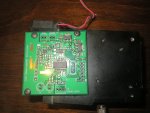Hello,
First of all, I am very pleased that here is a little movement again. So such communication is very constrictive and helpful to all.
It depends on which one you get and what grating it has. Mine is limited to 0.27nm, but I know you can get others that are much tighter. I am hoping to get an HR4000 in the future as it has a thousand more pixels than my USB2000. But, they are currently too expensive for me right now.
Mine has a 25 micron slit with a 600 l/mm grating. It measures from 350nm to 850nm
Hi Paul, here you describe the diffractive resolution of the very good USB2000.
Dividing the spectral width of a system by the number of pixels reproducing the image results in the maximum spectral width that can be represented per pixel, means optical resolution.
Now you've awakened again my interest in this USB2000 and I've looked at oceanoptics, what your constellation means in FWHM.
Link:
https://oceanoptics.com/knowledge-support/formula-calculating-optical-resolution/
Now I do not want to put the text in my own words, so here is a quote:
......
Formula for Calculating Optical Resolution
How to Calculate Optical Resolution
Optical resolution of a spectrometer, measured as Full Width Half Maximum (FWHM), depends on the groove density (mm-1) of the grating and the diameter of the entrance optics (optical fiber or slit).
Formula for Calculating Optical Resolution
1. Determine the spectral range of the grating. Look at the grating charts and note the value in the spectral range column in the chart.
For example, Grating #3 has a spectral range of ~650 nm.
Please note that the spectral range can vary by starting wavelength, which is why 650 nm is an approximation.
2. Determine the number of pixel elements in the spectrometer’s detector.
For a USB2000+ spectrometer, the number is 2048.
Divide the grating spectral range by the number of pixel elements in the detector.
This is your dispersion value. For our example, 650 nm/2048 pixels = 0.32 nm/pixel.
3. Choose a slit width. Each slit has a pixel resolution value.
For a USB2000+ with a 10 µm slit, this value is ~3.2 pixels.
You can lookup the pixel resolution for common spectrometer and slit combinations here.
Optical Resolution = Dispersion x Pixel resolution
In our example, the dispersion equals to 0.32 nm/pixel.
Multiply it by 3.2 of pixel resolution, and you get that the optical resolution of USB2000+ spectrometer with 10 µm slit is 1.02 nm."
......
Here in your concrete case that means in sum 500nm / 2048 = 2.44nm per pixel, as described by you.
this approx. 2.44nm per pixel multiplied by your dispersion factor of 4.2 gives approx. 1.025 nm FWHM.
Link:
https://oceanoptics.com/faq/choice-slit-size-affect-resolution/#pixel_resolution
Does that fit into something, can you confirm that?
Mine is hr2000 and does 0.2nm but more like 0.3-0.4. Very stable. I paid 1k off eBay. It sure grating. The seller is in Florida. I’ll look for his name. Also bought calibration source.
Spectrophoton is the seller. Contact him. His son also sells.spec
Hello kecked, what does that mean for your constellation, what do you have in your device?
This calculation can be found in the other spectrometer manufacturers in other expressions with approximately the same final result.
At B & W-TEK you can find this here:
Link:
http://bwtek.com/spectrometer-part-5-spectral-resolution/
Quote:
......
Calculating Spectral Resolution
When calculating the spectral resolution (δλ) of a spectrometer, there are four values you will need to know:
the slit width (Ws), the spectral range of the spectrometer (Δλ), the pixel width (Wp), and the number of pixels in the detector  .
.
It is also important to remember that spectral resolution is defined as the FWHM.
One very common mistake when calculating spectral resolution is to overlook the fact that in order to determine the FWHM of a peak,
a minimum of three pixels is required, therefore the spectral resolution (assuming the Ws = Wp) is equal to three times the pixel resolution (Δλ/n). This relationship can be expanded on to create a value known as resolution factor (RF), which is determined by the relationship between the slit width and the pixel width.
As would be expected, when Ws ≈ Wp the resolution factor is 3. When Ws ≈ 2Wp the resolution factor drops to 2.5, and continues to drop until Ws > 4Wp when the resolution factor levels out to 1.5.
All of this information can be summarized by the following equation,

For example, if a spectrometer uses a 25µm slit, a 14µm 2048 pixel detector and a wavelength range from 350nm – 1050nm, the calculated resolution will be 1.53nm.
.......
Here in my case that means:
Δλ =648 - 391 = 257 nm
Ws = 50 µm
Wp= 14 µm
n = 2048 pix
RF = 50/14*f(x) = ~ 1.8
- (δλ) = (1.8 x 257 x 50) / (2048*14) = 0.807 nm FWHM
That fits with the reality and my measures, and therefor ..... end of the possibilities of this device.
Ok, as you can see, in this constellation here you have a better FWHM than the above mentioned ocean optics configuration, but by far a considerable span spectral coverage of only about 250nm.
So you always have to decide what you want, either spectral resolution, or spectral coverage.




